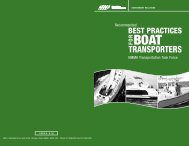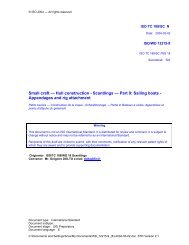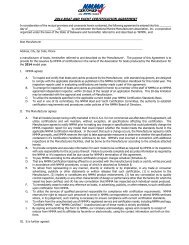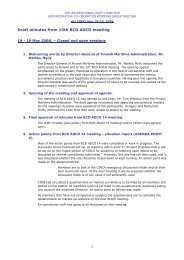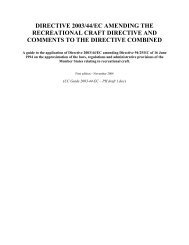global environmental legislation guide - National Marine ...
global environmental legislation guide - National Marine ...
global environmental legislation guide - National Marine ...
You also want an ePaper? Increase the reach of your titles
YUMPU automatically turns print PDFs into web optimized ePapers that Google loves.
A positive development for the marine industry is the increased influence of the BestAvailable Techniques in relation to the <strong>environmental</strong> permit.a. IPPC Directive (96/61/EC) and the review of IPPC Directive 2008/1/EC (IPPC isintegrated into the IED)The original directive (96/61/EC) on Integrated Pollution Prevention and Control (IPPC) wasadopted in 1996. The aim of IPPC is to achieve a high level of <strong>environmental</strong> protectionthrough integrated prevention and control of the pollution arising from a wide range ofindustrial and agriculture activities such as production of metals, minerals, chemicals, etc.Integrated pollution prevention and control is based on an <strong>environmental</strong> permit system forinstallations/companies. Member states must ensure that permits for the concernedindustrial processes within the facilities of companies comply with emission limit values.In essence, the original IPPC Directive aims to minimalize pollution from various industrialsources throughout the European Union.The original IPPC (96/61/EC) was reviewed in 2006 and put into effect January 2008, afterthe introduction of the IED (January 2011) all reviewed rules of IPPC 2008/1/EC had beenintegrated into the IED, Directive 2010/75/EU.b. Solvent Emission Directive 1999/13/EC (SED, integrated in the IED)The purpose of the Solvent Emissions Directive (SED) is to prevent or reduce the direct andindirect effects of emissions of volatile organic compounds (VOCs) from organic solventusers. The SED is not limited to air releases but relates to the control of fugitive releases toall media. The SED is aimed at the emission limits of the facilities within the (marine)companies and/or yards.Issues for the recreational marine and superyacht industries:• Many VOCs are harmful to human health. They can also undergo chemical reactionscausing the formation of ground-level ozone, an air pollutant. Therefore a reductionof VOC emissions is necessary. In general, the SED operators will have met SEDrequirements to achieve compliance. This could entail meeting an Emission LimitValue (ELV) in waste gases (mg/CN m3), a fugitive ELV (% of solvent use) or a totalemission limit value. These limitations can cause a reduction in the quality of thepainting process within the recreational marine and superyacht industries.• Due the review of the product directive (PD - 2004/42/EC) the thresholds for woodcoating might be lowered.The original SED (1999/13/EC) was reviewed in 2008/2009 with effect as of January 2010,after the introduction of the IED (January 2011) all reviewed rules of SED 1999/13/EC hadbeen integrated into the IED, Directive 2010/75/EU.The directive allows two approaches to achieve compliance:a) Product based limits9



